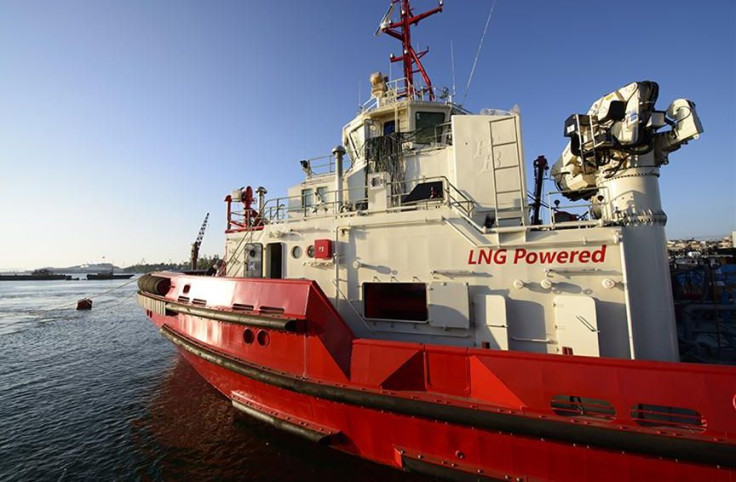How Liquid Natural Gas May Revolutionize Shipping, And Make Goods Cheaper

ISTANBUL -- At a noisy, bustling shipyard 20 miles south of Istanbul, the world’s second-ever tugboat powered by liquefied natural gas sits at the end of a pier, awaiting its first water trial.
“Then it’s off to Norway,” said with no little pride Ruchan Civgin, the contracts manager at Sanmar Shipyard, of the 115-foot vessel. “The first boat left in January.”
Further south along the Marmara Sea coast, another shipbuilder is rolling out LNG-powered fish-feed vessels, used to transport feed for fish farms, for international markets.
These ships may be the vanguard of a global boom in LNG-powered shipping, produced by the explosion in U.S. fracking and by new international emissions restrictions. Liquid natural gas may end up turning global shipping on its head, as shipping companies look for an edge in their battle to cut costs and reduce carbon footprints.
The world as we know it today would not exist without the behemoths that traverse the high seas. An astonishing 80 percent of global trade is carried by ship: the Nikes on your feet, the gasoline in your car, the Toyota Prius in your driveway all came on container ships.
In February, San Diego-based TOTE Shipholdings ordered the world's first LNG-powered container ships. It also plans to convert its fleet of four ships to LNG power. “The biggest driver is the environmental benefits of LNG,” said Ben Christian, TOTE project manager.
In January, the Mississippi-based Gulf Coast Shipyard Group launched the first of six LNG dual-fuel offshore supply vessels, the first of their kind in the Gulf of Mexico.
And in Europe, French operator Brittany Ferries recently ordered a massive, 2,500-passenger LNG-powered passenger ferry expected to enter service in 2017. General Electric (NYSE:GE) and petroleum giant Royal Dutch Shell (LON:RDSA) are also looking to get in on the act.
Fuel typically amounts to 70 percent of the overall cost of moving a container ship from A to B; most ships today run on cheap, dirty bunker fuel. It's a dense oil residue said to contain 2,700 times more toxic sulfur than vehicular fuels. According to studies cited by the watchdog group Transport & Environment, air pollution from shipping causes 50,000 deaths in Europe alone every year. Regulations to be introduced by the International Maritime Organization next year and in 2020 will make high-sulfur fuels, such as bunker fuel, illegal for use in ships sailing in numerous emission-control zones around the world.
Enter LNG, which, unlike bunker fuel, contains no harmful sulfur dioxide, emits 26 percent less carbon dioxide, and produces almost zero smoke.
And it’s cheaper than bunker fuel too.
According to Tim Delay, vice president of fuels for liquid natural gas distributor Pivotal LNG, a unit of AGL Resources Inc. (NYSE:GAS), gas contains more energy than bunker fuel. In the U.S., he said, this works out to around $100 per metric ton cheaper than bunker fuel.
"The relative low price of natural gas and LNG compared to current high residual bunker and distillate fuel prices in the U.S and Europe has added to the attractiveness of LNG," wrote Frederick Adamchak, an adviser at New York-based brokerage Poten & Partners, in an industry publication last year.
America is also flush with gas: the U.S. Energy Information Administration estimates there’s enough of it underground to last 92 years at expected demand.
And yet, of the 87,000 vessels that make up the global fleet today, LNG ships number just 50. So why isn't everybody converting their ships to a cheaper, abundant, cleaner fuel?
LNG presents challenges: building and converting ship engines takes time and is expensive. That's an important consideration in an industry where profit margins, hit hard by overcapacity after the global financial crisis, have shrunk in recent years.
Hundreds of LNG bunkering and refueling facilities will also have to be built at ports around the world.
“As of today, the infrastructure of LNG supply is limited and installation of LNG engines is an expensive investment. But LNG might be a viable solution for new-built container vessels sometime in the future when the infrastructure is in place,” said Mikkel Elbek Linnet, a spokesman for shipping giant Maersk Line, a unit of Denmark-based AP Moeller Maersk A/S (CPH:MAERSK-A).
Analysts say the number of ships converted to LNG will increase 20-fold by 2020. But in some cases, it's possible to reduce emissions and improve fuel consumption by using recycled engine heat and more efficient engines, rather than invest in an LNG conversion.
Maersk Line is doing just that with the launch last year of the first of a fleet of 20 massive ‘Triple E’ container ships, slow-sailing giants -- the longest ships in the world at 400 meters (1,312 ft) -- that recycle engine heat. Maersk says they will consume approximately 35 percent less fuel per container than some smaller vessels.
However, many major ports have already started the move to gas. The Belgian port of Antwerp, Europe’s second-busiest container port after Rotterdam in the Netherlands, expects to open bunkering facilities for LNG-powered ships at the end of next year. In February, ground was broken on America's first such facility at Port Fourchon, La.
TOTE Shipholdings wouldn’t say how much it expected to save by using LNG on its container carriers working the Jacksonville - Puerto Rico route.
But on a grander scale, vessels running on American LNG operating intercontinental routes could potentially save hundreds of thousands of dollars per journey. With gas prices forecast to remain steady for at least the next five years, cheaper shoes and cars may not be far off for North American consumers.
© Copyright IBTimes 2024. All rights reserved.





















